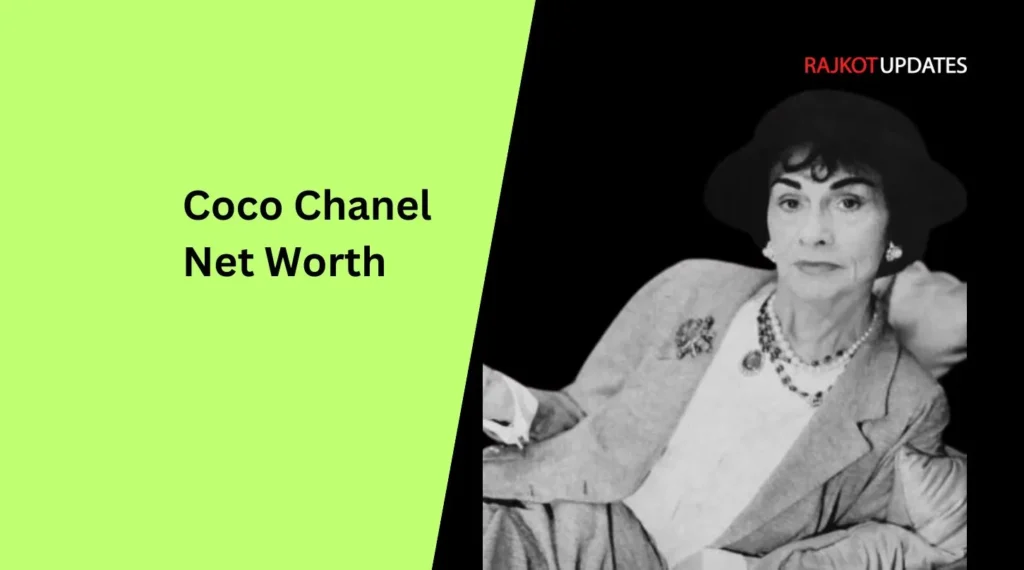At the time of her death in 1971, the iconic French fashion designer Coco Chanel net worth was $5 million.
Adjusted for inflation, this is equivalent to approximately $40 million today. As the founder of the Chanel brand, Coco Chanel amassed considerable wealth and fame.
She revolutionized women’s fashion post-World War I by designing handbags, jewelry, and fragrances, including the renowned Chanel No. 5.
In 1957, Chanel received the prestigious Neiman Marcus Fashion Award and is credited with creating the concept of the little black dress.
Chanel passed away on January 10, 1971, at the age of 87.
Coco Chanel Early Life
Coco Chanel was born Gabrielle Bonheur Chanel on August 19, 1883, in Saumur, France.
Her parents, Eugénie Jeanne Devolle Chanel and Albert Chanel, lived a challenging life.
Her mother worked as a laundrywoman, and her father was an itinerant street vendor.
The family led a nomadic lifestyle, moving between market towns and residing in rundown lodgings.
Chanel’s mother died when she was 11, and her father sent his daughters to an orphanage run by the convent of Aubazine while his sons became farm laborers.
At 18, Chanel moved to a boarding house for Catholic girls in Moulins.
She often embellished her childhood story, adding glamorous details that obscured her impoverished upbringing.
Founding of Chanel
Chanel began her career as a seamstress in Moulins and also sang in a cabaret, where she acquired the name “Coco.” During this time, she met Etienne Balsan, a young French ex-cavalry officer and textile heir, becoming his mistress and living with him for three years.
In 1908, she started an affair with Captain Arthur Edward “Boy” Capel, who financed her first shops.
She opened a boutique called Chanel Modes in Paris in 1910, designing hats that gained popularity when theatre actress Gabrielle Dorziat wore them.
By 1913, she had opened a successful boutique in Deauville and later in Biarritz, which allowed her to repay Capel’s investment.
In 1918, she purchased a building in a fashionable district of Paris and opened a boutique featuring clothing, hats, accessories, and later, jewelry and fragrances.
By 1927, she operated five properties in the district, making her fashion line immensely successful.
The Wertheimer Deal
In the 1920s, Chanel designed dance costumes for the Ballets Russes and met Théophile Bader, founder of Paris Galeries Lafayette, who wanted to sell her perfume, Chanel No. 5, in his store.
This led to the creation of Parfums Chanel, with investor Pierre Wertheimer owning 70%, Bader 20%, and Chanel just 10%. Chanel soon regretted this deal and unsuccessfully tried to renegotiate.
Today, Pierre Wertheimer’s sons, Alain and Gerard, own 100% of the brand, with a combined net worth of $90-100 billion.
1930s and Beyond
By the late 1930s, Chanel had established herself as Paris’s preeminent designer.
However, she closed her shops at the onset of World War II, deeming it inappropriate to focus on fashion during such times.
Pierre Wertheimer appointed a Nazi-friendly “Aryan” proxy owner for the business, and Chanel faced accusations of being a Nazi collaborator, forcing her to flee to Switzerland after the war.
While in Switzerland, she created a new perfume line, nearly resulting in a lawsuit from Wertheimer.
They eventually reached an agreement in 1947, with Wertheimer paying her $400,000, agreeing to a 2% royalty from No. 5 sales, and providing a perpetual monthly stipend.
Chanel stopped selling her Swiss perfumes, relinquished her 10% stake in Parfums Chanel, and sold her rights to the name “Coco Chanel.”
Coco Chanel Legacy
Coco Chanel’s legacy is marked by her popularization of a sporty, casual chic style for women, moving away from restrictive corseted silhouettes.
She remains the only designer listed on Time magazine’s list of the 100 most influential people of the 20th century.
Her designs and products, such as Chanel No. 5 and the interlocked-CC monogram, have become iconic.
Coco Chanel Personal Life and Death
Chanel was romantically involved with Arthur Capel for much of her life, even after he married an English aristocrat.
Their relationship continued until his death in 1919. She also had relationships with Grand Duke Dmitri Pavlovich of Russia and composer Igor Stravinsky, as well as a close friendship with Misia Sert, with whom she developed a drug habit.
Chanel later had an affair with the Duke of Westminster, Hugh Richard Arthur Grosvenor, an outspoken antisemite.
During World War II, she lived at the Hotel Ritz in Paris, where German military staff also resided, and was accused of sympathizing with the Nazis and working as a spy for the Germans.
After the war, Winston Churchill intervened to protect her from punishment, allowing her to return to Paris.
Chanel died in January 1971 at the Hotel Ritz, where she had lived for over 30 years. Her funeral was attended by models and fashion designers.
While her impact on women’s fashion is undeniable, her reputation has been reexamined in light of her Nazi ties.
Also Read:
Conclusion
Coco Chanel’s transformative influence on fashion endures, epitomized by her iconic creations and the timeless elegance she brought to women’s wardrobes.
Despite the controversies that clouded her personal life, her contributions to fashion remain significant and celebrated.
Chanel’s legacy is a testament to her innovation, resilience, and the indelible mark she left on the fashion industry.






